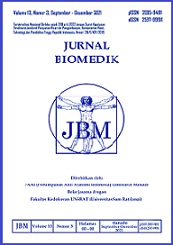SHORT TANDEM REPEATS (STRs) AS A PRIMARY METHOD FOR PERSONAL IDENTIFICATION (A Case Report)
DOI:
https://doi.org/10.35790/jbm.1.1.2009.811Abstract
Abstrak: Mayat seorang perempuan tak dikenal yang ditemukan di daerah Malalayang dibawa oleh polisi ke Rumah Sakit Umum Pusat Prof.dr.R.D Kandou. Mayat tersebut telah mengalami proses awal pembusukan. Selain itu pihak kepolisian mengalami kesulitan untuk menentukan identitas mayat tersebut serta menemukan keluarganya. Demi pengungkapan kejadian yang menyebabkan kematian perempuan tak dikenal ini, terlebih dahulu polisi harus dapat menentukan identitas mayat. Melalui data medis yang dikumpulkan dari proses autopsi forensik, digabungkan dengan daftar orang hilang yang dibuat oleh kantor kepolisian Sektor Malalayang dan Kepolisian Kota Besar Manado, ditemukan kecocokan data yang merujuk pada seorang perempuan yang dilaporkan hilang oleh keluarganya. Polisi kemudian meminta pemeriksaan identifikasi melalui metode analisis DNA untuk membandingkan DNA mayat dengan DNA individu-individu yang mengaku sebagai keluarga korban. Pada saat autopsi forensik, diambil sampel tulang padat iga kanan dan kiri sepanjang 10 cm dari mayat. Sebagai pembanding diambil apusan mukosa pipi dan 2 cc darah tepi dari individu-individu yang diduga ayah dan adik kandung dari mayat yang ditemukan. Proses ekstraksi, kuantifikasi, PCR, dan proses analisis akan dilakukan di Pusat Laboratorium Forensik Kepolisian Republik Indonesia.
Kata kunci: identitas mayat, identifikasi DNA, PCR, STR.
Â
Â
Abstract: Ms X’s corpse was brought to Prof.R.D Kandou general hospital by police officers. Ms X was found in Malalayang without any identity attached to her body. Her body had begun to decompose, and the police had difficulties in finding Ms X’s relatives. In order to uncover the case behind Ms X’s death, the police had to first discover the true identity of Ms X. Medical data was acquired during an autopsy, and from a list that the police made, a match was found in a report of missing persons when two data were compared. The Police requested a paternity DNA examination in order to have a positive identification of Ms X. During the forensic autopsy of Ms X, 10 cm of left and right costal compact bones were obtained. Buccal swabs were made and 2 cc of peripheral blood were taken, each from the suspected father and a suspected sister of Ms X. Extraction, quantification, PCR, and the analysis was made at Pusat Laboratorium Forensik Kepolisian Republik Indonesia the main Police Forensic Laboratory of Indonesia. PCR involves 13 to 15 of nuclear STR loci, and the analyzing process of the samples involves comparing the 13 to 15 nuclear STR loci of the 3 people. If a match is found with 99% accuracy, then identification is verified. The Paternity Index indicates the greatest possibility that the suspected father is the real father of Ms X, compared to other males in the Asian / Indonesian Population.1
Keywords: corpse identity, DNA identification, PCR, STR.
Downloads
Issue
Section
License
Penyunting menerima sumbangan tulisan yang BELUM PERNAH diterbitkan dalam media lain. Naskah yang masuk dievaluasi dan disunting keseragaman format istilah dan cara penulisan sesuai dengan format penulisan yang terlampir dalam jurnal ini.
Segala isi dan permasalahan mengenai tulisan yang yang diterbitkan dalam jurnal menjadi tanggung jawab penuh dari penulis.







